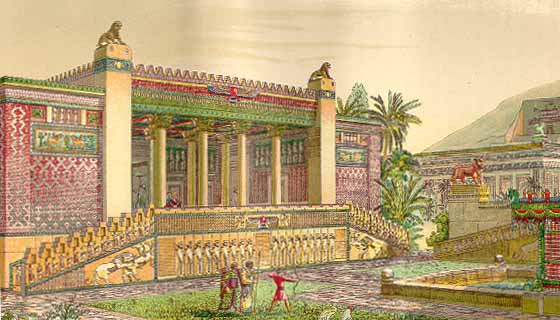|
Series:
Visual Essays
Author:
Jamshid Varza
Subtopics:
Reference:
Related
Articles:
Related
Links:
|
The sunrise
on Novruz indicated the start of the new year in the Persian Empire
Persepolis, the seat of the Achaemenian kings, is
a vast palace located near Shiraz in the Fars province of Iran. The
Persian Empire was founded by Cyrus in about 550 BCE. The empire of Cyrus and
his descendents spanned from the borders of Greece to China, and from Asia Minor
to Egypt, and lasted for over 200 years till 330 BCE. Darius the Great started
the construction of Persepolis and his son Xerxes continued and finished the
palace. Every Achaemenian king, following the tradition of Darius, added to this
magnificent complex of palaces.

Persepolis was
built at the foot of a mountain now called Rahmat, which was known throughout
Iranian history as Kuh-e Mehr or Komehr . The Iranian astronomer, Yahya Zokka,
discovered that about 487 BCE all the Iranian calendars merged into a single
beginning year. The so-called milestone was the Novruz celebration of 487 BCE at
the height of the reign of Darius the Great. Darius built a vast road system and
established a land tax collection plan throughout his empire. He established
Novruz 487 BCE as the beginning of a new annual cycle for his empire.
Zokka
discovered that on the same year on the day of Novruz, the first rays of the sun
rising above Komehr illuminated a square stone set in the central hall of
Persepolis. The square rock could not be used for any other purpose, only to
mark the rise of the Novruz Sun in the palace. The main hall was used for large
formal gatherings. Tablets found in the palace also mention the great festival
celebrated about 487 BCE in the palace. Zokka concludes that from 487 BCE
onward, the Achaemenian kings celebrated the advent of the Novruz sunrise in the
main hall of Persepolis.
Images
carved on Persepolis rocks and reliefs symbolize the seasonal change. The image
of a lion dominating a bull can be seen in several places in entry ways and step
carvings. The lion symbolized spring and the bull symbolized winter for ancient
Iranians. The dominance of the lion over the bull symbolized the arrival of
spring in the empire.
A feast for your eyes...Click here to start
|